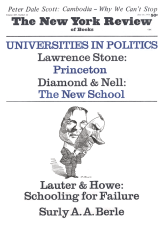In response to:
A Special Supplement: Cambodia from the June 4, 1970 issue
To the Editors:
In an article on Cambodia in the issue of June 4, I mentioned that Jean-Claude Pomonti of Le Monde is one of the few correspondents to have reported in depth from Cambodia. Not surprisingly, he has since been expelled from the country as an “undesirable alien.” The loss, for those interested in knowing the facts, is serious, as was the expulsion of his colleague Jacques Decornoy from Saigon several years ago.
Meanwhile in Cambodia there have been several interesting developments. Our man in Saigon has officially rejected the “silly argument of silly people” that “if some day the Americans leave Cambodia then the South Vietnamese will have to follow them out of Cambodia too.” On the same day on which General Ky spoke so frankly in Saigon, a spokesman for the Lon Nol government, Major Amrong, declared that “we will never be dominated by the Vietnamese—that is why the population is rising against them.” He noted explicitly that he referred to all Vietnamese. General Do Cao Tri, Saigon commander in the “Parrot’s Beak” area, explained the difficulty of determining whether the Cambodians in the villages being occupied “are for Sihanouk, Lon Nol or the Vietcong.” He also complained of the unwillingness of the Cambodian army to fight. The Saigon troops, however, are going from success to success, leaving behind them a trail of devastated Cambodian villages. Similarly, on May 20 “American troops reported having found the bodies of 33 Cambodian civilians who were apparently killed by an American B-52 bombing strike last night” (New York Times). Reports of ground fighting are not dissimilar (apart from official military handouts, that is—the latter are of course almost worthless as a source of information). The Americans are reported as being quite satisfied by the aggressiveness displayed by the Saigon troops.
According to Figaro, General Ky stated that eleven airfields are being constructed in Cambodia by the Saigon army to facilitate air operations. American sources in Washington now admit that Salgon troops may remain indefinitely and that they may be reinforced with Thai units. The fundamental reason for this is explained in a report by Tad Szulc in The New York Times, May 21, summarizing the views of “senior officials” of the American Government: “…the Lon Nol regime will need assistance to deal with guerrilla and subversive activities…in some ways the situation developing in Cambodia [is] beginning to resemble South Vietnam in 1960, when the Vietcong began their rebellion against the Saigon regime.” It is reassuring to learn that senior American officials are now beginning to comprehend (or at least admit) what has been fairly obvious to readers of the world press since shortly after the March 18 coup in Cambodia.
It is a reasonable guess that the Saigon army, unable to control any substantial territory in South Vietnam without massive American support, will fare no better in its efforts to prop up the Lon Nol government. Therefore direct American involvement will no doubt have to continue at a high level. But given the mood in the United States, it will have to be kept from the public. Hence it is likely that the control of news will have to be still further increased, on the Laotian model. This morning’s New York Times (May 24) probably gives a fair forecast of what all this means for the Cambodians. A frontpage story reports that a dozen Cambodian guerrillas were killed in a new ARVN offensive against an “enemy regiment” in Indochina’s biggest rubber plantation. Twenty-five more of “the enemy” (nationality unidentified) were reported slain. Witnesses reported that Saigon air force planes bombed and strafed a rubber processing plant, killing at least fifteen workers. They report also that “no Vietnamese Communist soldiers had ever been in the plant.” Shortly after, planes were reported to have attacked the surrounding villages, the central market, and the principal school. Another headline reads: “Cambodian drive called success by US commanders.” For General Ky and his American colleagues, the American invasion may be a short-range success. For anyone else, it is an unmitigated tragedy.
Noam Chomsky
Department of Foreign Literatures and Linguistics
MIT
Note: The editors regret that, through no fault of the author, the following errors appeared in the text of Noam Chomsky’s article on Cambodia in the last issue (NYR, June 4, 1970). The correct address of the Bulletin of the Concerned Asian Scholars is: 1737 Cambridge St., Cambridge, Mass. (p. 39). On page 40, column 2, Michael Leifer should have been identified as a British scholar now at the London School of Economics. In the remaining corrections, the corrected or added words appear in italics. Page 39, column 2, 5 lines from bottom: and North Vietnamese who now control. Page 40, column 2, 39 lines from bottom: Kranh…[which] was then invaded and burnt by United States-South Vietnamese troops”; 32 lines from bottom: insert “165 sea violations,” after the words “border violations”; 1 line from bottom: UN Document S/7820 3/15/67. Page 40, column 3, 7 lines from top: Vietnamese and American bombing; 11 lines from top: South Vietnamese-imposed blockade. Page 45, column 1, 6 lines from top: the prince turned towards Moscow. Page 46, column 4, 26 lines from bottom: Cambodian civilians.
This Issue
June 18, 1970



